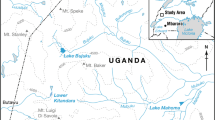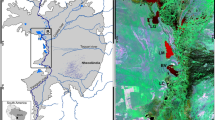Abstract
Short sediment cores (80–100 cm) from three Florida (USA) lakes (Sheelar, Wauberg, and Apopka) that range in trophic status, were analyzed for total organic carbon (TOC), total nitrogen, stable isotopes of organic carbon (δ13CTOC) and biomarkers (n-alkanes and fatty acids), to identify the sources of organic matter in the lake deposits, and to link changes in primary productivity to anthropogenic activities during the last ~ 150 years. Relatively small (0.07 km2), ultra-oligotrophic Lake Sheelar is located in a state park, and sediment analyses indicate stable trophic status in the water body since at least the middle of the nineteenth century. Algal biomarkers are in low abundance throughout the core and terrestrial lipids and δ13CTOC values suggest that vascular plants were the primary source of TOC to the lake sediments during the period of record. In larger, eutrophic Lakes Wauberg (1.5 km2) and Apopka (125 km2), algal-derived biomarkers increase in recent sediments, whereas δ13CTOC values and concentrations of terrestrial biomarkers decrease toward the sediment surface. Increasing dominance through time of autochthonous carbon sources in the Lake Wauberg and Apopka sediment records coincides with specific anthropogenic activities in the respective watersheds. Submersed macrophytes in Lake Wauberg were replaced by algal communities in the mid-1980s, following expansion of residential development in the watershed. Biomarker data from the Lake Apopka core show there was an abrupt transition in the lake in the late 1940s, from domination by vascular plants to domination by algae, which has been documented by other paleolimnological studies that used alternative trophic state indicators. The trophic state shift in Lake Apopka corresponds to a period of increased nutrient input to the lake, associated with extensive farming along the north shore. Florida lakes have experienced different trophic state trajectories over the last ~ 150 years, driven by specific human activities in their respective watersheds.





Similar content being viewed by others
References
Anderson DM, Glibert PM, Burkholder JM (2002) Harmful algal blooms and eutrophication: nutrient sources, composition, and consequences. Estuaries 25:704–726
Appleby PG, Oldfield F (1983) The assessment of 210Pb data from sites with varying sediment accumulation rates. Hydrobiologia 103:29–35
Arnold TE, Kenney WF, Curtis JH, Bianchi TS, Brenner M (2018) Sediment biomarkers elucidate the Holocene ontogeny of a shallow lake. PLoS ONE 13:e0191073
Bianchi TS, Canuel EA (2011) Chemical biomarkers in aquatic ecosystems. Princeton University Press, Princeton
Binford MW (1990) Calculation and uncertainty analysis of 210Pb dates for PIRLA project lake sediment cores. J Paleolimnol 3:253–267
Brenner M, Binford MW, Deevey ES (1990) Lakes. Ecosystems of Florida. University of Central Florida Press, Orlando
Brenner M, Whitmore TJ, Curtis JH, Hodell DA, Schelske CL (1999) Stable isotope (δ13C and δ15N) signatures of sedimented organic matter as indicators of historic lake trophic state. J Paleolimnol 22:205–221
Canuel EA (2001) Relations between river flow, primary production and fatty acid composition of particulate organic matter in San Francisco and Chesapeake Bays: a multivariate approach. Org Geochem 32:563–583
Carr AF (1934) The plankton and carbon dioxide-oxygen cycle in Lake Wauberg, Florida. Master’s Thesis University of Florida, Gainesville
Castañeda IS, Schouten S (2011) A review of molecular organic proxies for examining modern and ancient lacustrine environments. Quat Sci Rev 30:2851–2891
Correll DL (1998) The role of phosphorus in the eutrophication of receiving waters: a review. J Environ Qual 27:261–266
Craft CB, Richardson CJ (1997) Relationships between soil nutrients and plant species composition in Everglades peatlands. J Environ Qual 26:224–232
Craft CB, Vymazal J, Richardson CJ (1995) Response of Everglades plant communities to nitrogen and phosphorus additions. Wetlands 15:258–271
Cranwell PA, Eglinton G, Robinson N (1987) Lipids of aquatic organisms as potential contributors to lacustrine sediments—II. Org Geochem 11:513–527
Diefendorf AF, Freeman KH, Wing SL (2014) A comparison of terpenoid and leaf fossil vegetation proxies in paleocene and eocene Bighorn Basin sediments. Org Geochem 71:30–42
Donar C, Stoermer EF, Brenner M (2009) The Holocene paleolimnology of Lake Apopka, Florida. Nova Hedwig 135:57–70
Ficken KJ, Li B, Swain DL, Eglinton G (2000) An n-alkane proxy for the sedimentary input of submerged/floating freshwater aquatic macrophytes. Org Geochem 31:745–749
Filley TR, Freeman KH, Bianchi TS, Baskaran M, Colarusso L, Hatcher PG (2001) An isotopic biogeochemical assessment of shifts in organic matter input to Holocene sediments from Mud Lake, Florida. Org Geochem 32:1153–1167
Fisher MM, Brenner M, Reddy KR (1992) A simple, inexpensive piston corer for collecting undisturbed sediment/water interface profiles. J Paleolimnol 7:157–161
Florida Department of Environmental Protection (FDEP) (2008) Integrated Water Quality Assessment for Florida: 2008 305(b) Report and 303(d) List Update. Florida Department of Environmental Protection, Division of Environmental Assessment and Restoration, Bureau of Watershed Management. Tallahassee, FL, 142 p
Florida LAKEWATCH (2003) Florida LAKEWATCH Annual Data Summaries 2002. Department of Fisheries and Aquatic Sciences, University of Florida/Institute of Food and Agricultural Sciences, University of Florida, Gainesville, FL. http://lakewatch.ifas.ufl.edu
Gu B, Schelske CL, Hodell DA (2004) Extreme δ13C enrichments in a shallow hypereutrophic lake: implications for carbon cycling. Limnol Oceanogr 49:1152–1159
Gu B, Chapman AD, Schelske CL (2006) Factors controlling seasonal variations in stable isotope composition of particulate organic matter in a soft water eutrophic lake. Limnol Oceanogr 51:2837–2848
Haddad RI, Martens CS, Farrington JW (1992) Quantifying early diagenesis of fatty acids in a rapidly accumulating coastal marine sediment. Org Geochem 19:205–216
Haglund AL, Lantz P, Törnblom E, Tranvik L (2003) Depth distribution of active bacteria and bacterial activity in lake sediment. FEMS Microbiol Ecol 46:31–38
Hasler AD (1947) Eutrophication of lakes by domestic drainage. Ecology 28:383–395
Ho ES, Meyers PA (1994) Variability of early diagenesis in lake sediments: evidence from the sedimentary geolipid record in an isolated tarn. Chem Geol 112:309–324
Kenney WF, Schelske CL, Chapman AD (2001) Changes in polyphosphate sedimentation: a response to excessive phosphorus enrichment in a hypereutrophic lake. Can J Fish Aquat Sci 58:879–887
Kenney WF, Whitmore TJ, Buck DG, Brenner M, Curtis JH, Di JJ, Kenney PL, Schelske CL (2014) Whole-basin, mass-balance approach for identifying critical phosphorus-loading thresholds in shallow lakes. J Paleolimnol 51:515–528
Kenney WF, Brenner M, Curtis JH, Arnold TE, Schelske CL (2016) A holocene sediment record of phosphorus accumulation in shallow Lake Harris, Florida (USA) offers new perspectives on recent cultural eutrophication. PLoS ONE 11:e0147331
Landsberg JH, Flewelling LJ, Naar J (2009) Karenia brevis red tides, brevetoxins in the food web, and impacts on natural resources: decadal advancements. Harmful Algae 5:598–607
Magill CR, Ashley GM, Freeman KH (2013) Water, plants, and early human habitats in eastern Africa. Proc Natl Acad Sci 110:1175–1180
Meyers PA (1997) Organic geochemical proxies of paleoceanographic, paleolimnologic, and paleoclimatic processes. Org Geochem 27:213–250
Meyers PA (2003) Applications of organic geochemistry to paleolimnological reconstructions: a summary of examples from the Laurentian Great Lakes. Org Geochem 34:261–289
Muri G, Wakeham SG (2006) Organic matter and lipids in sediments of Lake Bled (NW Slovenia): source and effect of anoxic and oxic depositional regimes. Org Geochem 37:1664–1679
Nichols JE (2011) Procedures for extraction and purification of leaf wax biomarkers from peats. Mires Peat 7:1–7
Palomo L, Canuel EA (2010) Sources of fatty acids in sediments of the York River estuary: relationships with physical and biological processes. Estuar Coasts 33:585–599
Parkes RJ, Taylor J (1983) The relationship between fatty acid distributions and bacterial respiratory types in contemporary marine sediments. Estuar Coast Shelf Sci 16:173–189
Pearson A, McNichol AP, Benitez-Nelson BC, Hayes JM, Eglinton TI (2001) Origins of lipid biomarkers in Santa Monica Basin surface sediment: a case study using compound-specific Δ14C analysis. Geochim Cosmochim Acta 65:3123–3137
Peterson BJ, Fry B (1987) Stable isotopes in ecosystem studies. Annu Rev Ecol Evol Syst 18:293–320
Riedinger-Whitmore MA, Whitmore TJ, Smoak JM, Brenner M, Moore A, Curtis J, Schelske CL (2005) Cyanobacterial proliferation is a recent response to eutrophication in many Florida lakes: a paleolimnological assessment. Lake Reserv Manag 21:423–435
Schelske CL (1997) Sediment and phosphorus deposition in Lake Apopka. Final Report (Spec Publ SJ97-SP21) to the St. Johns River Water Management District, Palatka, FL https://www.sjrwmd.com/documents/technical-reports/special-publications/1997-1993/
Schelske CL, Peplow A, Brenner M, Spencer CN (1994) Low-background gamma counting: applications for 210Pb dating of sediments. J Paleolimnol 10:115–128
Schelske CL, Coveney MF, Aldridge FJ, Kenney WF, Cable JE (2000) Wind or nutrients: historic development of hypereutrophy in Lake Apopka, Florida. Adv Limnol 55:543–563
Schelske CL, Lowe EF, Battoe LE, Brenner M, Coveney MF, Kenney WF (2005) Abrupt biological response to hydrologic and land-use changes in Lake Apopka, Florida, USA. Ambio 34:192–198
Shumate BC, Schelske CL, Crisman TL, Kenney WF (2002) Response of the cladoceran community to trophic state change in Lake Apopka, Florida. J Paleolimnol 27:71–77
Silliman JE, Schelske CL (2003) Saturated hydrocarbons in the sediments of Lake Apopka, Florida. Org Geochem 34:253–260
Swain EB (1985) Measurement and interpretation of sedimentary pigments. Freshw Biol 15:53–75
Torres IC, Inglett PW, Brenner M, Kenney WF, Reddy KR (2012) Stable isotope (δ13C and δ15N) values of sediment organic matter in subtropical lakes of different trophic status. J Paleolimnol 47:693–706
Wakeham SG, Forrest J, Masiello CA, Gélinas Y, Alexander CR, Leavitt PR (2004) Hydrocarbons in Lake Washington sediments. A 25-year retrospective in an urban lake. Environ Sci Technol 38:431–439
Waters MN, Schelske CL, Kenney WF, Chapman AD (2005) The use of sedimentary algal pigments to infer historic algal communities in Lake Apopka, Florida. J Paleolimnol 33:53–71
Waters MN, Schelske CL, Brenner M (2015) Cyanobacterial dynamics in shallow Lake Apopka (Florida, USA) before and after the shift from a macrophyte-dominated to a phytoplankton-dominated state. Freshw Biol 60:1571–1580
Watts WA (1980) The late quaternary vegetation history of the southeastern United States. Annu Rev Ecol Syst 11:387–409
Whiticar MJ (1999) Carbon and hydrogen isotope systematics of bacterial formation and oxidation of methane. Chem Geol 161:291–314
Zhang X, Bianchi TS, Allison MA (2015) Sources of organic matter in sediments of the Colville River delta, Alaska: a multi-proxy approach. Org Geochem 87:96–106
Author information
Authors and Affiliations
Corresponding author
Additional information
Publisher's Note
Springer Nature remains neutral with regard to jurisdictional claims in published maps and institutional affiliations.
Rights and permissions
About this article
Cite this article
Arnold, T.E., Brenner, M., Kenney, W.F. et al. Recent trophic state changes of selected Florida lakes inferred from bulk sediment geochemical variables and biomarkers. J Paleolimnol 62, 409–423 (2019). https://doi.org/10.1007/s10933-019-00096-y
Received:
Accepted:
Published:
Issue Date:
DOI: https://doi.org/10.1007/s10933-019-00096-y




